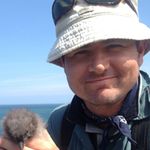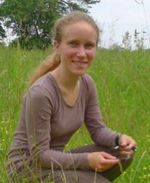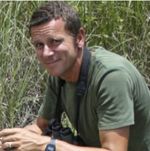
Programme > Sessions
Le programme général du colloque est disponible dans l'onglet "planning" et le programme détaillé peut être téléchargé ici.
Le colloque sera organisé autour de cinq sessions thématiques
Ecophysiologie chez les animaux sauvages
Conférencier invité : Dr. Jonathan Green (Institute of Integrative Biology- Université de Liverpool, UK)
 |
Jon Green s'intéresse à l'écophysiologie et au comportement des oiseaux marins. Ces animaux doivent s'adapter à 2 environnements très contrastés: les contraintes de se nourrir dans une grande étendue d'eau à des profondeurs souvent importantes, des températures froides et à faible luminosité sont très différentes de celles subies lorsque ces espèces se reproduisent et muent à terre. Chaque environnement (et leurs contraintes associées) change de manière saisonnière et annuelle, et est sous menace anthropogénique liée à la surpêche, le changement climatique et les développements d'énergie renouvelabes. --------------------------------------------------------------------- Ecophysiology in free-ranging seabirds: Insights from energetics approaches Seabirds are the perfect model group in which to study ecophysiology. Firstly their lifestyle compels them to spend time at sea, on the land and in most cases in the air, and these very different environments present a number of simultaneous physiological challenges that they have to adapt to. Secondly, seabirds are the world’s most threatened group of birds, experiencing population declines due to climate change, overfishing, habitat loss and invasive species. For the last 20 years I have worked on projects which have attempted to increase our understanding of how this fascinating group of animals functions in, and is influenced by, their environment using energetics as a common currency to link behaviour, physiology and ecology. From migration in Arctic cormorants to fine-scale decision making in kittiwakes to windfarm interactions in gannets, I will talk about work from the past, present and future that attempts to highlight the importance of understanding ecophysiology in all free-ranging animals. |
Changements environnementaux, flexibilité métabolique et épigénétique
Conférencier invité : Prof. Christoph Grunau (IHPE UMR 5244 - Université de Perpignan Via Domitia)
 |
Christoph Grunau s'intéresse au rôle de l'épigénétique dans l'évolution. L'objectif de son groupe est de comprendre les interactions entre l’environnement, les organismes et l’adaptabilité («fitness»), au laboratoire et en populations naturelles, afin de mieux comprendre les interactions entre hôtes et symbiotes et/ou parasites et de proposer des stratégies de contrôle. Sa vision de l'héritabilité est inclusive et basée sur les notions de biologie de système ; elle intègre la transmission d'éléments génétiques, épigénétiques, cytoplasmiques et de symbiotes qui engendrent un phénotype en interaction avec l'environnement. --------------------------------------------------------------------- A systems biology approach to epigenetic inheritance Evolution is based on the selection of phenotypic variants that must (i) confer a reproductive advantage to the individual, and (ii) are heritable. Heritability has traditionally be though to be exclusively genetic, i.e. based on variations in the DNA sequence. During the last years it became however clear, that a substantial amount of heritable phenotypic variance can be coded by non-genetic means. We have conceptualised this view as a systems approach to inheritance that includes genetic, epigenetic, cytoplasmic and microbial elements. They interact mutually with the environment to give raise to the phenotype. Exemples from our lab will be used to illustrate this concept (parental effects in oyster, adaptation of the human parasite Schistosoma mansoni, and immune memory in invertebrates). |
Conférencier invité : Prof. Walter Arnold (University of Vetenary Medecine, Vienna)
 |
La recherche de Walter Arnold se situe à l'interface écologie-physiologie. Il travaille sur divers aspects de l'acclimatation saisonière: énergetique, thermorégulation, hibernation, rythmes saisonniers et circadiens. Un point central de sa recherche se focalise sur les fonctions physiologiques des acides gras polyinsaturés, notamment le rôle de ces composés alimentaires essentiels sur la composition phospolipidique membranaire en relation avec la régulation endogène saisonnière. Il étudie les effets des acides gras polyinsaturés dans une diversité d'espèces (petits hibernants aux grands mammifères) allant du niveau moléculaire au niveau de l'organisme. --------------------------------------------------------------------- Seasonal acclimatization: From the whole organism to the fatty acid composition of membranes Mammals and birds living in seasonal environments face during winter a two-fold challenge: The energetic cost of maintaining a high body temperature is higher at lower ambient temperatures while food availability and quality is poor.Hibernators and daily heterotherms cope with these challenges by switching to fat reserves as the major metabolic fuel, reducing locomotor activity, and, most importantly, by abandoning maintenance of a high body temperature. We found similar reactions in several non-hibernating large mammals, except that temperature changes were only substantial in peripheral body parts. Nevertheless, metabolic rate, approximated by continuous measurement of heart rate, was in these species during winter also remarkably reduced, to about half of the summer level. The reduction of body temperature is in hibernators preceded by incorporation of essential polyunsaturated fatty acids (PUFA) into phospholipids (PL). Upon termination of hibernation, these PUFA are cleared again from PL. First results from red deer suggest that similar remodeling of membranes also occurs in species undergoing only minor seasonal changes of core body temperature. A change of the PL environment apparently can compensate temperature (Arrhenius) effects on membrane-bound enzymes, but with specific roles for different PUFA. For instance, activity of the sarcoplasmic reticulum Ca++-ATPase (SERCA) is increased in membranes rich in omega-6 linoleic acid (LA), a mechanism presumably pivotal during hibernation by ensuring proper Ca++ handling in cardiac myocytes at low body temperatures. In contrast to LA, PL-omega-3 docosahexaenoic acid seems to improve ATP production but has detrimental effects on SERCA. I conclude that seasonal acclimatization, in particular hypometabolism and voluntary hypothermia seem to be ubiquitous among endotherms, as is associated membrane remodeling. Specific effects of PUFA in PL suggest trade-offs determining a state-dependent optimization of the fatty acid composition of membranes. |
Plasticité et qualité individuelle
Conférencière invitée : Dr. Charlotte Récapet (ECOBIOP UMR 1224, Université Pau Pays de l’Adour)
 |
Centrées sur l’individu, les recherches de Charlotte Récapet s’attachent à comprendre le maintien de la diversité de stratégies d’histoire de vie observée au sein des populations. Elle s’intéresse en particulier aux rôles du métabolisme énergétique et du stress oxydant dans les compromis d’histoire de vie et dans la réponse des individus aux variations environnementales. Ses études combinant des approches de terrain, expérimentales et de modélisation, permettent d’identifier les mécanismes mais également les conséquences démographiques et évolutives de la diversité des histoires de vie. --------------------------------------------------------------------- Doing poorly or doing differently? An evolutionary view on individual quality Because of its tight links to medical science, physiology has often adopted a normative view of individual state and classified the deviation from average of individual markers as “healthy” or “pathogenic”. This framework, inherited from the medical need of simple biomarkers for health and disease, has led to the transposition or creation of various physiological metrics into the fields of ecology and evolutionary biology. Although simple to use, such metrics can be misleading, as they are usually too simple to capture the complexity of biological and ecological systems. First, the life of organisms involves complex regulatory systems that make individual biomarkers, taken separately, poor predictors of individual quality. Crude mathematical summaries of these biomarkers, instead of improving our understanding of the biological processes at play, usually obscure them. On the opposite, various approaches have been developed that make a better use of our improved computing capacity to understand individual variation in physiological state and its relevance to individual fitness. Then, a biomarker can show different response according to individual and environmental characteristics, e.g. individual variation in reaction norms. Far from being random noise, this individual variation may relate to evolutionary relevant variation in life-history strategies. Disregarding this source of variation when classifying individuals along a “poor” to “successful” axis will thus often lead to inappropriate conclusions on the ecology and evolution of the species. Adopting a more integrative and individualized view of physiology could therefore help us understand the mechanisms underlying individual variation in life-history strategies and behaviour, but also improve the communication between evolutionary biology and the developing field of evolutionary medicine. |
Activités humaines et physiologie de la conservation
Conférencier invité : Prof. Christian Voigt (Leibniz Institute for Zoo and Wildlife, Berlin)
 |
Christian C. Voigt s'intéresse aux mécanismes fonctionnels définissant la résistance et résilience des populations animales. Il étudie à la fois des facteurs proximaux (écologique, physiologique) et ultimes. Ses études sont surtout centrées sur le modèle chiroptère, espèces revêtant une grande diversité écologique en termes de traits d'histoire de vie (longévité, hibernation, vol) et d'importance fondamentale dans de nombreux écosystèmes. Son groupe au Leibniz Institute for Zoo and Wildlife Research, utilise à la fois des approches de terrain et de laboratoire (comportement, isotopes stables, respirométrie, endocrinologie, immunologie) afin de mieux comprendre les réponses de populations sauvages au dérangement humain. --------------------------------------------------------------------- Anthropogenic activities and conservation physiology In the newly-defined geological epoch of the Anthropocene animals are exposed to a multitude of anthropogenic threats. Indeed, while witnessing the 6th mass extinction event and the disappearance of species in real-time, we are yet at the starting point of understanding the causes that are responsible for the survival or extinction of species. Conservation physiology is pivotal for developing a mechanistic understanding of how e.g. degrading habitats influence animals on the individual, population and species level. Physiological pathways sensitive to sensory stress, nutritional status, chronic hormonal stress and deprived immunology are at the core for understanding and predicting the long-term survival of animals in human-shaped landscapes. In my research, I focus on a taxon that is particularly susceptible towards anthropogenic threats: Bats. Bats are long-lived and highly mobile. They reproduce at a low rate and use torpor to survive adverse conditions. In our group, we studied the body condition, immunology and pathogen load of bats in fragmented rainforests of Borneo to develop a predictive framework that helps to estimate the survival probability of forest species. For example, we found that tree-dwellings bats are more susceptible to chronic stress than cave-dwelling bats in forest fragments, which makes tree-dwelling species more likely to perish from forest patches; probably because they are more dependent on local food resources and thus more susceptible to temporal and spatial fluctuations of food than cave-dwelling bats with larger home ranges. In Europe, some tree-dwelling bat species are migrating annually over more than 4,000 km. As a consequence, they cross a multitude of habitats which exposes them to various threats, including misleading sensory cues from anthropogenic sources, low-quality habitats with reduced insect biomass and an increased mortality risks at wind turbines. In the last part of my talk, I will summarize our recent insights into these anthropogenic threats and assess how they might impact the physiology and survival of migratory bats during their seasonally journeys. Conservation physiology contributes to an understanding of mechanisms underlying biodiversity losses and may thus have the potential to mitigate or even reverse some of the detrimental effects that humans have on animals and ecosystems worldwide. |
Ecophysiologie comportementale
Conférencier invité : Prof. Wolfgang Goymann (Max Planck Institute for Ornithology, Seewiesen)
 |
Wolfgang Goymann s'intéresse aux inter-relations entre écologie, physiologie, et comportement animal, et à comment différents environnements et histoires de vie façonnent les mécanismes physiologiques affectant le comportement. Afin de survivre et se reproduire avec succès, la morphologie, la physiologie et le comportement animal doivent être adaptés aux conditions environmentales. De fait, l'évolution a façonné une myriade de traits et de stratégies d'histoire de vie permettant aux animaux de gérer les contraintes de l'environnement. Comprendre les mécanismes physiologiques sous-jacents le comportement et les traits d'histoire de vie des espèces animales, ainsi que la flexibilité des systèmes de régulation physiologiques constitute un point clé dans notre compréhension de l'impact des changements environnementaux liés aux perturbations anthropiques sur les espèces et populations animales. --------------------------------------------------------------------- Male-to-female testosterone ratios, dimorphism and life history in birds – and what may be different about females Testosterone is a key hormone for the development of secondary sexual characters and dimorphisms in behavior and morphology of male vertebrates. Because females often express detectable levels of testosterone, testosterone has been suggested to also play a role in the modulation of secondary sexual traits in females. Previous comparative analyses in birds and fish demonstrated a relationship between male-to-female testosterone ratios and the degree of sexual dimorphism. Furthermore, female maximum testosterone was related to mating system and coloniality. In this presentation, I will re-evaluate these previous ideas using phylogenetic analyses and effect size measures for the relationship between birds’ male-to-female maximum testosterone levels. Further, I will investigated the seasonal androgen response of female birds (the difference from baseline to maximum testosterone), which in males is strongly related to mating system. I could not confirm a relationship between male-to-female testosterone, maximum female testosterone, or the seasonal androgen response of females with most of the previously investigated life history parameters. I will elaborate on why the expectation that testosterone regulates traits in females in a similar manner as in males may be misleading and should be reconsidered, and exemplify this using an example of hormonal factors influencing territorial aggression in sex-role reversed female black coucals. |
Le comité scientifique est composé de membres internes (DEPE, IPHC) :
François Criscuolo
Caroline Habold
Yves Handrich
Sylvie Massemin
Jean-Patrice Robin
Vincent A Viblanc
et de membres externes :
Fabrice Bertile (DSA-IPHC, Strasbourg)
Etienne Challet (INCI, Strasbourg)
Jehan-Hervé Lignot (MARBEC, Montpellier)
Nathalie Mondy (LEHNA, Lyon)
David Renaud (ECOBIO, Rennes)
Yann Voituron (LEHNA, Lyon)
| Personnes connectées : 1 | Flux RSS |

|
